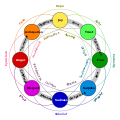Early childhood (birth to 3 years old)
Attachment
Attachment refers to the strong bond that individuals develop with special people in their lives. Though we can have attachment relationships with significant others in adulthood, such as marital partners, most humans’ first and most influential attachment is with their primary caregiver(s) as infants. John Bowlby and Mary Ainsworth first delineated and tested attachment theory as an evolutionarily informed process in which the emotional ties to a caregiver are adaptive for survival. [5] Their research supported the presence of four stages of attachment formation: [6] [7]
- Undiscriminating social responsiveness (0–3 months) – Instinctual infant signals, such as crying, gazing, grasping, help facilitate caregiver interactions with infants. Infants do not consistently discriminate with whom they signal or how they respond.
- Preferential social responsiveness (3–6 months) – Infants now clearly respond differently to primary caregiver(s) than strangers. Infants have learned that this caregiver will consistently respond to their signals.
- Emergence of secure-base behavior (6–24 months) – Young children use their attachment figure as a “secure base” from which to explore the world and a “safe haven” to return to for reassurance or comfort. When the attachment figure is not available, children may exhibit separation anxiety.
- Partnership (24 months and older) – Children develop an internal working model about the availability and responsiveness of attachment figures that can impact their future behavior and relationships.

Early attachment is considered foundational to later social-emotional development, and is predictive of many outcomes, including internalizing problems, externalizing problems, social competence, self-esteem, cognitive development, and achievement. [6] Mary Ainsworth's work using the Strange Situation method identified four types of attachment styles in young children:
- Secure attachment: Children in this category are willing to explore the room/toys independently when their caregiver is present. They may cry when separated, but seek out comfort and are easily soothed when their caregiver returns. This style is associated with sensitive, responsive care by the attachment figure.
- Anxious/Avoidant attachment: Children in this category tend to be less responsive to separation from their caregiver, do not differentiate as clearly between caregivers and strangers, and are avoidant of caregivers upon return. This style is associated with overstimulating care or by consistently detached care.
- Anxious/Ambivalent attachment: Children in this category may seek out closeness with caregiver and appear unwilling to explore. They show distress upon separation and may appear both mad (e.g., hitting, struggling) and clingy when the caregiver returns. These children are often harder to soothe. This style is associated with inconsistent responsiveness or maternal interference with exploration.
- Disorganized attachment: Children in this category often do not show a predictable pattern of behavior, but may be non-responsive or demonstrate flat affect. This style is associated with unpredictable and/or frightening experiences with caregivers, and is more common in children who have experienced maltreatment.
Emotional experiences
Emotional expression

Beginning at birth, newborns have the capacity to signal generalized distress in response to unpleasant stimuli and bodily states, such as pain, hunger, body temperature, and stimulation. [6] They may smile, seemingly involuntarily, when satiated, in their sleep, or in response to pleasant touch. Infants begin using a “social smile,” or a smile in response to a positive social interaction, at approximately 2 to 3 months of age, and laughter begins at 3 to 4 months. [6] Expressions of happiness become more intentional with age, with young children interrupting their actions to smile or express happiness to nearby adults at 8–10 months of age, and with markedly different kinds of smiles (e.g., grin, muted smile, mouth open smile) developing at 10 to 12 months of age. [6]
Between 18 and 24 months, children begin to acquire a sense of self. This gives rise to the onset of self-conscious emotions (e.g., shame, embarrassment, guilt, pride) around that same age, which are considered more complex in nature than basic emotions such as happiness, anger, fear, or disgust. This is because they require that children have recognition of external standards, and evaluative capacities to determine whether the self meets that standard. [8]
Emotion regulation
Emotion regulation can be defined by two components. The first, “emotions as regulating,” refers to changes that are elicited by activated emotions (e.g., a child's sadness eliciting a change in parent response). [9] The second component is labeled “emotions as regulated,” which refers to the process through which the activated emotion is itself changed by deliberate actions taken by the self (e.g., self-soothing, distraction) or others (e.g., comfort). [9]
Throughout infancy, children rely heavily on their caregivers for emotion regulation; this reliance is labeled co-regulation. Caregivers use strategies such as distraction and sensory input (e.g., rocking, stroking) to regulate infants’ emotions. Despite a reliance on caregivers to change the intensity, duration, and frequency of emotions, infants are capable of engaging in self-regulation strategies as young as 4 months. At this age, infants intentionally avert their gaze from overstimulating stimuli. [6] By 12 months, infants use their mobility in walking and crawling to intentionally approach or withdraw from stimuli. [6]
Throughout toddlerhood, caregivers remain important for the emotional development and socialization of their children, through behaviors such as: labeling their child's emotions, prompting thought about emotion (e.g., “why is the turtle sad?”), continuing to provide alternative activities/distractions, suggesting coping strategies, and modeling coping strategies. [6] Caregivers who use such strategies and respond sensitively to children's emotions tend to have children who are more effective at emotion regulation, are less fearful and fussy, more likely to express positive emotions, easier to soothe, more engaged in environmental exploration, and have enhanced social skills in the toddler and preschool years. [6]
Understanding others
Social referencing

Starting at about 8–10 months, infants begin to engage in social referencing, in which they refer to another, often an adult or caregiver, to inform their reaction to environmental stimuli. [6] In the classic visual cliff experiments, 12-month-old babies who were separated from their mothers by a plexiglass floor that appeared to represent a dangerous “cliff” looked to their mothers for a cue. [10] When mothers responded to their infants with facial expressions signaling encouragement and happiness, most infants crossed over the cliff. In contrast, if mothers displayed fear or anger, most infants did not cross.
As infants age, their social referencing capacity becomes more developed. By 14 months, infants are able to use information gained from social referencing to inform decisions outside of the immediate moment. [6] By 18 months, infants are able to socially reference interactions not directed at them. [6] For example, if their caregiver responded with anger when their older brother went to take a cookie, the infant is able to harness that information and is less likely to take a cookie themselves. At this age, social referencing also begins to support children's understanding of others, as children learn what others like and dislike based on the information gained from social referencing (e.g., facial expression). As such, if an adult reacts by smiling when given a ball but with anger when given a doll, an 18-month-old will choose to give that adult a ball, rather than a doll, regardless of their own preferences.
Empathy
From an early age, newborns are reactive to others’ distress, as evidenced by behaviors such as crying in response to another infant's cry. As children continue to develop, they begin to display behaviors that indicate an understanding of and connection to others’ emotional states beyond the simple informational value those emotional states provide. Children at 18–30 months will respond to verbal and nonverbal cues, such as facial expressions or body posture, of discomfort or sadness with simple helping behaviors (e.g., giving an adult a blanket if they are shivering, rubbing their arms, and saying “brr”). [11] Throughout this period (18–30 months), children become more adept and need fewer cues to engage in helping behavior. [11] However, helping behavior at this age is already dependent on the cost of helping (e.g., they are less likely to give the adult their own blanket) and the recipient of the help (e.g., children are more likely to help and show concern for caregivers than strangers or peers). [11]
Social interactions
Between 3 and 6 months old, infants begin engaging in simple back-and-forth exchanges, often with their caregivers. [6] These exchanges do not consist of words, but of coos, gurgles, smiles or other facial expressions, and bodily movements (e.g., lifting arms, kicking legs). [12] These back and forth exchanges mimic the turn-taking that occurs in conversations.
Joint attention
Joint attention refers to the ability of individuals to share a common point of reference or attention. [13] In children, this common point of reference often is an object in the environment, such as a toy. The development of joint attention initially starts with the infants' ability to respond to joint attention bids (e.g., looking where their parent looks), and eventually develops with age to the ability to initiate joint attention by directing the attention of another to shared point of reference. [13] This can be done through many means, including gaze, gesture (e.g., pointing, showing), or speech.
As early as 3 to 4 months of age, infants show the beginning requisites of joint attention, by looking in the general direction as adults; however, they are not consistently able to find the shared point of reference. [6] At 10 months, this accuracy improves, [6] and infants are also more discerning in their response to joint attention. For example, at this age, a 10-month-old will not look in the same direction as an adult if that adult's eyes are closed, a mistake that younger children make. [13] Initiation of joint attention begins at approximately 1 year old. [6] This might look like a child pointing to an airplane, then looking at their mom, and back at the airplane, as if to say "do you see that?" or "look at that!"
Joint attention is a critical social skill that drives development in other domains. Joint attention enables infants to identify objects that adults are labeling and promotes shared back-and-forth communication about them. Fifteen-month-old infants who were engaged in interactions with caregivers that include a joint attentional focus (e.g., a toy) demonstrated more frequent communicative utterances than when not in joint attention episodes. [14] These episodes of joint engagement were predictive of later vocabulary and word learning, especially when the joint attention was focused on an object that the infant was initially attending to, [14] such as when an infant picks up a ball, then the mother engages in a joint attention episode with the infant using the ball as the shared point of reference. At later ages, when initiating joint attention, the frequency that a child combines one word with a gesture (e.g., pointing to the plane and saying "plane") is associated with earlier onset of multi-word utterances, and more complex speech overall at 3.5 years old. [6]


